- Details
- Written by Gordon Prentice
The latest polls show Doug Ford’s Progressive Conservatives way ahead of the opposition in the run up to the Provincial Election on 2 June. 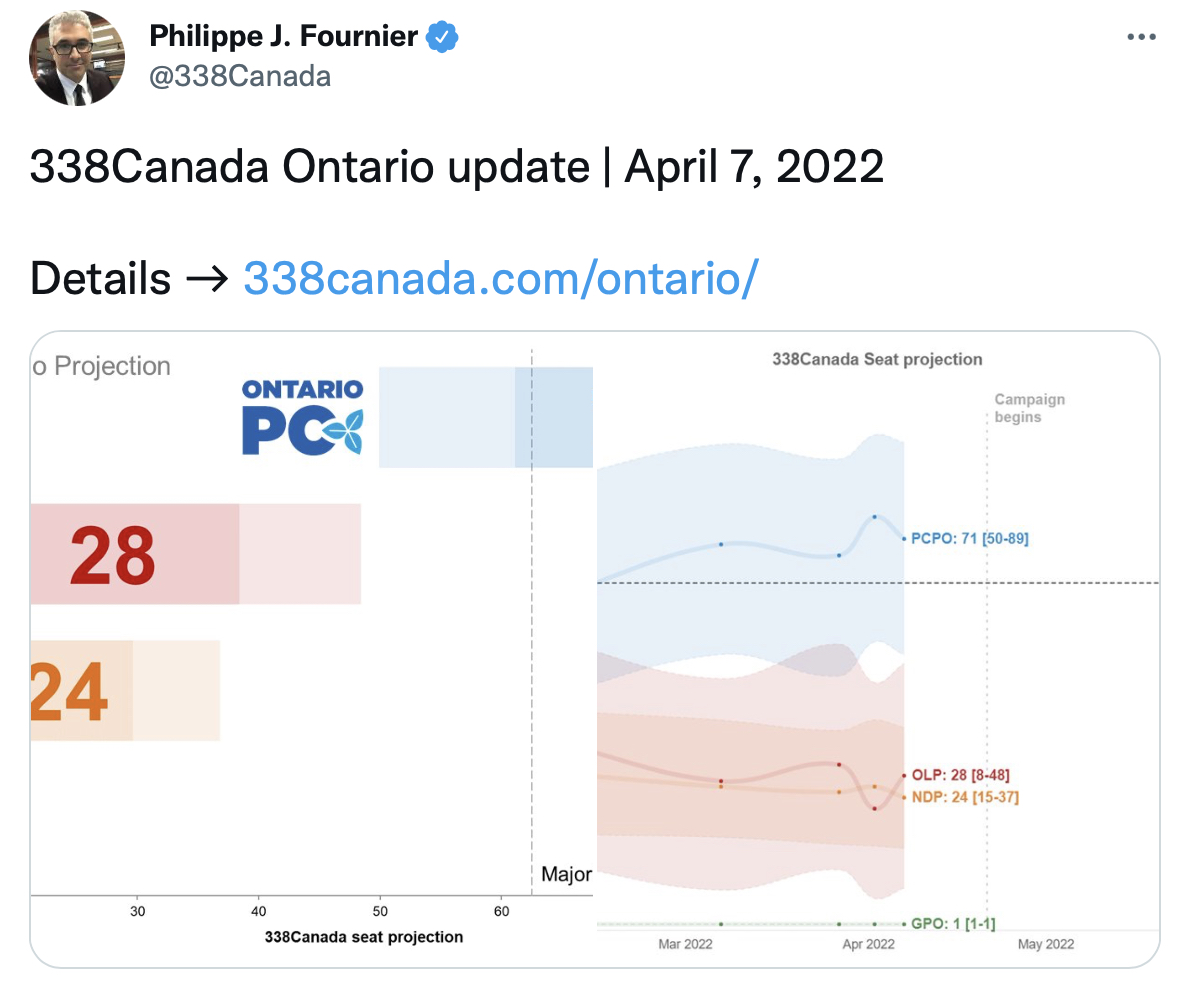
The respected polling aggregator 338canada.com regularly shows the PCs getting over 35% support with the Liberals and the NDP jockeying for second place getting support around the 26% mark. Because of our First-Past-the-Post system this translates into a majority Ford government. But, of course, a lot can happen during the campaign which doesn’t officially start until 4 May 2022.
Bribing the voters
For the moment, Ford is hard at work bribing the voters, targetting motorists. Ford's decision to abolish the license plate fee and send out refunds (costing the Province $1.1B in lost revenue) was a taste of things to come. We’ve seen the abolition of road tolls on Highways 412 and 418 and go-aheads for construction of Highway 413 and the Bradford Bypass. Then there’s the cut in gas duty and raising the speed limits on some 400 series highways.
"Ironclad guarantee"
We can expect more eye-popping announcements in the Provincial budget which has been postponed until later this month to get closer to the election. The PCs passed a new law in 2019 requiring the delivery of budgets by March 31 – described by the then Finance Minister, Vic Fedeli, as “an ironclad guarantee”.
So much for that.
Ford has promised the health sector millions. Bringing down the deficit used to be the standard war-cry of the Progressive Conservatives. But it doesn’t seem to matter these days. Ontario’s budget deficit amounted to $1,597 per person in 2020, the fifth highest in the country.
A new Southlake
Here in Newmarket, we are promised a new Southlake. Like everyone else in Town I want to see a new hospital. The one we have is overcrowded and there is no room to expand. So, we are told the solution lies in two sites: the current one at Davis Drive is to become a walk-in centre with the acute facilities going to a new – as yet unidentified – greenfield site, ideally within 10km of the Davis Drive site.
Personally, I think the two-site solution is a second best. There are synergies when medical facilities are clustered together. But the land simply isn’t available for Southlake to grow on its present site – and over the years no-one took the trouble - nor had the insight - to acquire it.
In the bag 
The PCs talk about the new hospital as if it’s in the bag. The back-slapping and whoops of congratulation have been deafening. But, in reality, all Southlake is getting is a cheque from the Province for $5M to help it work up its plans. The hospital’s January 2020 Master Plan is not publicly available nor is the Province’s response. We don’t know where the promised acute hospital will be located nor when it will be built. Not even a provisional date.
The same formulation (promising a new hospital but giving a few million dollars to work up the plans) is used elsewhere – for example, in Barrie and Brant – coupled with gushing quotes from local PC MPPs.
We need to spend more on health. Not just talk about it.
Ontario has lowest health spending in Canada
Last week the Financial Accountability Office of Ontario published a report comparing Ontario’s fiscal results with the other provinces after the first year of the COVID-19 Pandemic. It shows that, on a per person basis, Ontario’s total program spending in 2020 was the lowest in the country, with the least amount in health spending.
“Health spending per person in Ontario was $4,800 in 2020, the lowest in Canada and $536 (10.0 per cent) below the average of the other provinces… Since 2008 when the data is first available, Ontario has consistently had among the lowest levels of per person health spending in the country.”
Buck-a-Beer certainly knows how to spin a tale.
And, for the moment, it looks like the voters will buy it.
This email address is being protected from spambots. You need JavaScript enabled to view it.
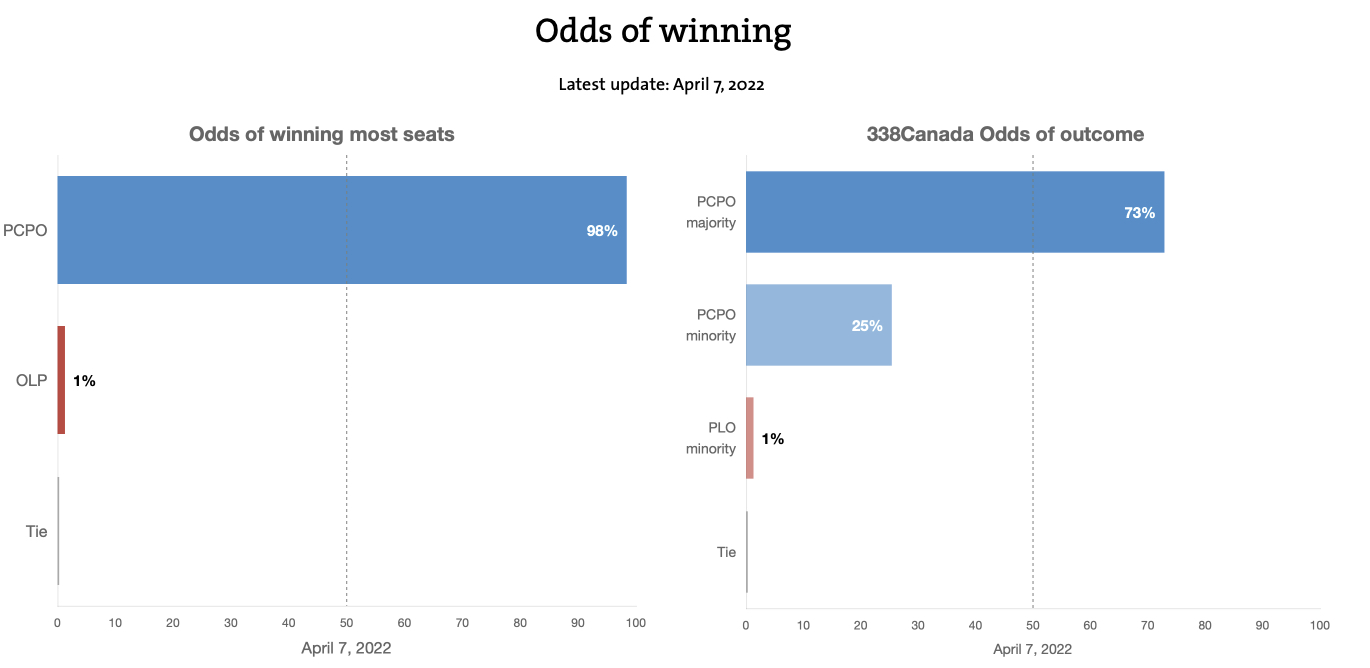
- Details
- Written by Gordon Prentice
The big news out of the UK this week was the jaw-dropping revelation that Akshata Murty, the wife of the UK’s Chancellor of the Exchequer, Rishi Sunak, is “non-UK domiciled” for tax purposes. This means she does not pay UK tax on her worldwide income despite living in Number 11 Downing Street, rent free, paid for out of the public purse. 
She claims domicile in India where she was born and her parents live.
She says she will now pay full UK taxes on her worldwide income but the UK's Guardian newspaper reports that Murty will retain her non-dom status:
"which could in future allow her family to legally avoid an inheritance tax bill of more than £275m".
India does not have an inheritance tax.
The Guardian reports that:
“Under non-dom rules, Murty did not legally have to pay tax in the UK on the estimated £11.5m (CAN$18.6M) in annual dividends she collects from her stake in Infosys, her billionaire father’s IT business. UK tax residents would be expected to pay about £4.5m (CAN$7.2M) in tax on the dividend payment.”
It was an astonishing admission. But, in one sense, it didn’t surprise me. The super-rich have long benefitted from complex rules designed specifically to lighten their tax burden – or eliminate it entirely.
"Little people"
The late New York real estate heiress, Leona Helmsley, famously remarked
"only the little people pay taxes."
Then she went to jail.
Here there is no suggestion Murty broke the law, only that she used the arcane rules on domicile to her clear advantage. It is estimated that Murty may have avoided paying £20M (CAN$32.4M) to the UK Treasury, which her husband heads as Chancellor of the Exchequer.
Despite saying yesterday that she would be paying UK tax in future on her worldwide income there are still questions to answer.
Time to get rid of non-dom status
But after this latest scandal it is surely time for the UK to get rid of its special category of taxpayers, the non-doms, which is an absurd hangover from the days of Empire.
We know the overwhelming majority of UK taxpayers play by the rules.
The super-rich, by contrast, play the system.
This email address is being protected from spambots. You need JavaScript enabled to view it.
Updated and this from the Observer 10 April 2022: Top Conservatives say Rishi Sunak's chances of becoming Prime Minister are over. And from Andrew Rawnsley: The Stench of Entitlement
- Details
- Written by Gordon Prentice
Lord Black of Crossharbour, who renounced his Canadian citizenship to join the House of Lords in 2001, has been on leave of absence from the Lords since 5 September 2017. He has spoken twice in the Lords – the last time over twenty years ago. So why on earth does he want to remain a member of the UK Parliament? And, more to the point, why would the Lords want him back? 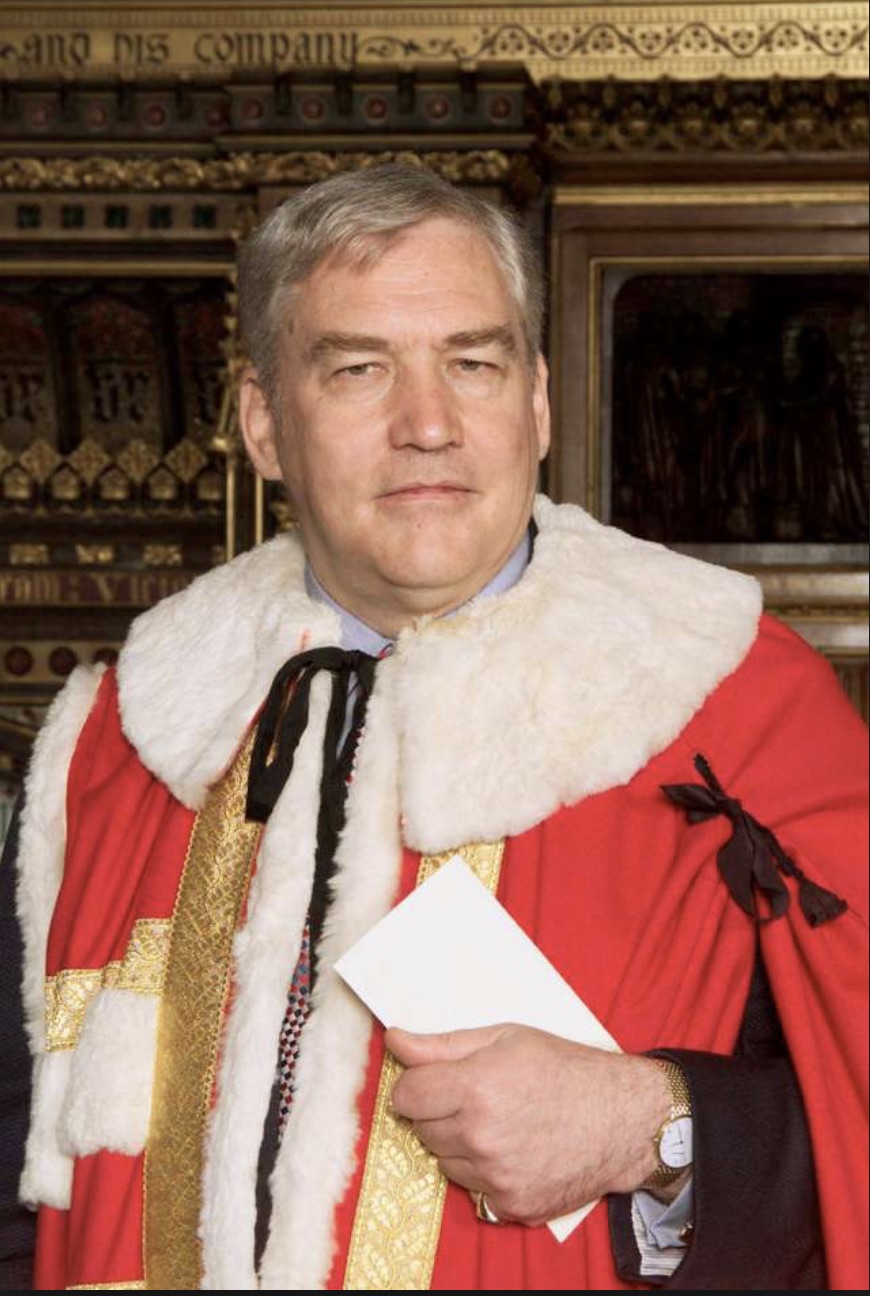
Black seems to be happy enough here in Canada, holding forth on the major political issues of the day. He told readers of the National Post on 7 December 2018:
“I do expect to reapply as a Canadian citizen eventually — I have been mainly living here for nearly seven years, have not had so much as a parking ticket and have certainly been a substantial taxpayer.”
Defamation Threat
I can remember the exact date on which I first became intrigued by Conrad Moffat Black and his blustering style. On 24 July 2019 he threatened to sue me for defamation for describing his Lordship as a convicted fraudster – which he is. Personally, I think it an outrage that a convicted felon like Black should still be a member of the Westminster Parliament.
The House of Lords Reform Act 2014 originally proposed that a peer convicted of a serious offence overseas (imprisonment for one year or more) should be automatically disqualified from the Lords - as is the case for a sentence handed down by the Courts in the UK. However, the Bill was later amended to allow the House of Lords to vote on whether disqualification should apply in the case of a conviction overseas.
That said, there is absolutely no doubt in my mind that had Black gone to jail after 14 May 2014 (when the Bill received Royal assent) he would have been expelled from the Lords.
UK Parliament = UK taxes
Since 2010, the Constitutional Reform and Governance Act deems all members of the UK Parliament to be “resident, ordinarily resident and domiciled in the UK for tax purposes”. At the time, Ministers said there was a clear expectation that members of the UK Parliament should pay UK taxes. S41 was the vehicle for doing this, deeming or treating members of Parliament as being UK resident and UK domiciled for tax purposes even if, in reality, they were not UK resident or UK domiciled. In practice, peers can live anywhere they choose, including Canada.
But, not unreasonably, the 2010 Act obliges all members of the UK Parliament to pay UK taxes on their worldwide income. As there is no payroll reference for House of Lords members (because they do not receive a salary for attending, only expenses) it is their responsibility to declare their worldwide income to HMRC (Her Majesty’s Revenue and Customs). There is no absolute requirement for peers to file a tax return. They must do so only if they fulfil the Self-Assessment criteria.
The system is built on trust. HMRC does not keep a record of which members of the House of Lords are non-UK resident and/or non UK domiciled.
This change in the law – obliging UK Members of Parliament to pay UK taxes on their worldwide income - was triggered by my 2007 Freedom of Information request on the tax status of the multi-millionaire Conservative peer, the slippery tax dodger, Lord Ashcroft. On 1 March 2010 Ashcroft admitted for the first time that, throughout his ten-year membership of the Lords, he had been non-domiciled, meaning that he was not paying UK tax on his worldwide income – despite giving a clear and unequivocal assurance in 2000 that he would do so.
Coleman Federal Correctional Facility, Florida. 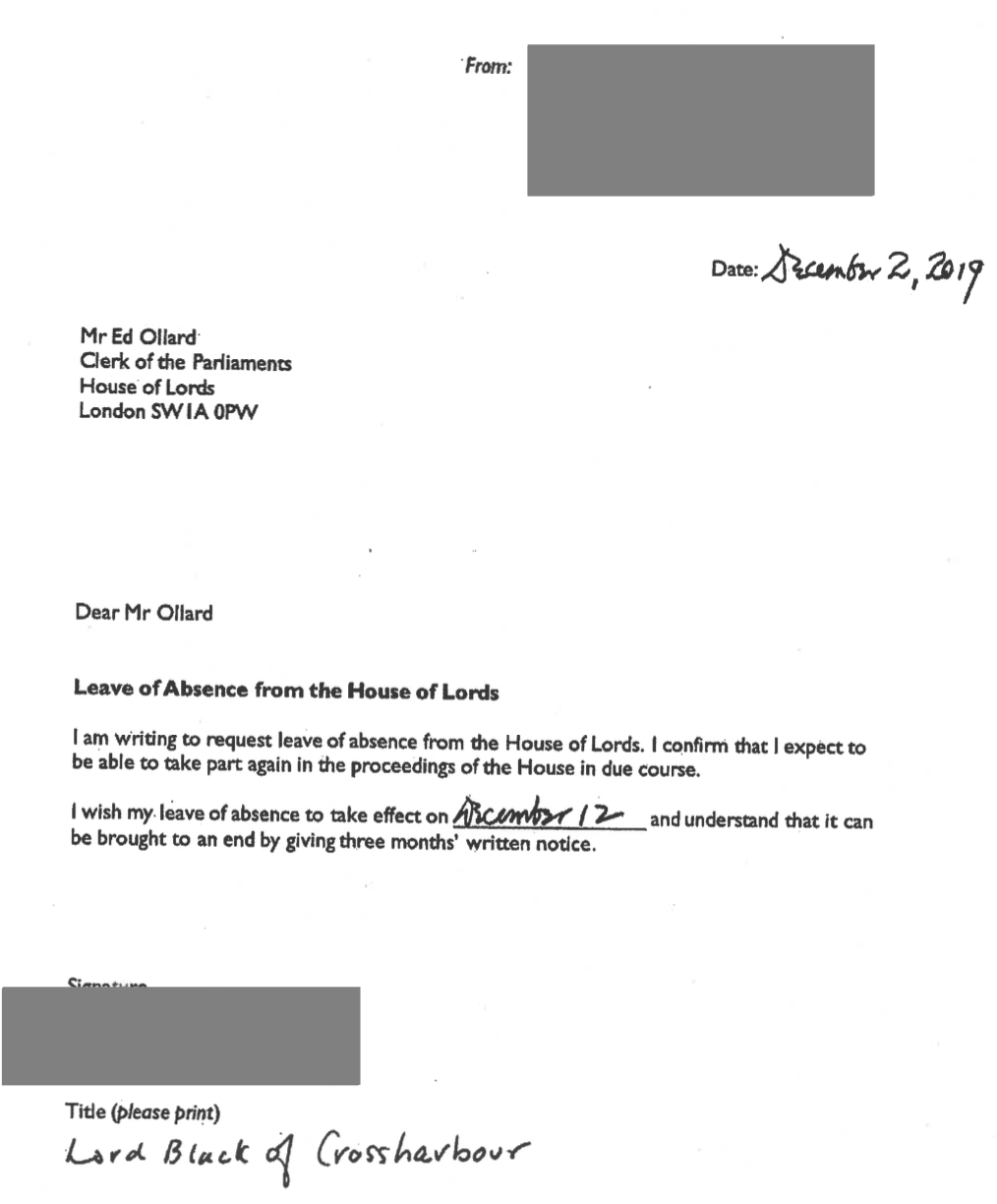
When the Constitutional Reform and Governance Act became law Conrad Black was serving time in the Coleman Federal Correctional Facility in Florida. He may have been unaware of the Act and how it might affect him. I don’t know. But since then he has pretty much stayed away from Westminster, taking leave of absence from the Lords on 5 September 2017.
From time-to-time Black teases about returning to the Lords. He told his National Post readers on 7 December 2018:
“I have enjoyed it (membership of the House of Lords) and though I have been officially inactive for some years, I have returned and been generously received and look forward to resuming my full active membership.”
We are not told who generously received him. But we do know he has not bothered to apply for an Official Pass (though, quaintly, as a peer he does not actually need one to get into the building).
On 30 May 2019 the BBC reported that, after his “pardon” by Trump, Black was planning a return to the Lords but it all came to nothing.
Leave of Absence
At the start of every new Parliament peers are asked if they intend to participate in the work of the Chamber. If, for any reason, they are unable to give that commitment they can (a) resign from the House of Lords or (b) request leave of absence. In the latter case, they tell the Clerk of the Parliaments they are temporarily unable to fulfill their duties as a member but
“expect to be able to take part again in the proceedings of the House in due course”.
This is a notoriously elastic undertaking. However, in recent years the House of Lords Procedure Committee has been quietly closing the loopholes which allow absentee peers like Black to retain their membership of the Lords. (Click "Read More" below for details)
The recent revision of the Lords Standing Orders (February 2021) advises peers that:
“When applying for leave of absence, a member of the House should state in their written application the date by which they expect to return, the reason for their leave of absence and that they have a reasonable expectation that they will be in a position again to take part in the proceedings of the House.”
Sleeping Member
Black, a sleeping member, is totally disengaged from the work of the Lords. He no longer posts an official portrait. He has been inactive for so long that he has been exempt from registering any interests in the Lords Register of Members Interests for more than a decade.
In the light of this, I am left wondering if peers on leave of absence, like Black, have forgotten about the Constitutional Reform and Governance Act 2010 and its requirement that all members of the UK Parliament pay UK taxes on their worldwide income.
Last year I raised this issue with Lord Gardiner of Kimble, the Senior Deputy Speaker who chairs the House of Lords Procedure Committee. He told me that, having reflected on the points I made, he recognised:
“there was a possibility that members of the House may be unaware that Section 41 of the Constitutional Reform and Governance Act 2010 continues to apply when they are on leave of absence’
He told me:
“I think it is important that the House does what it can to ensure all members understand their position on leave of absence, so I am currently exploring options for reminding members going on leave of absence that they must continue to be resident, ordinarily resident and domiciled in the UK for tax purposes. One option is to add such a reminder to the letter sent to members going on leave of absence by the Clerk of the Parliaments. I am taking that forward.”
By the time of the next UK General Election (which could be as far away as January 2025) Conrad Black may well be living in the UK with his wife, Barbara Amiel.
$14,000,000 mortgage 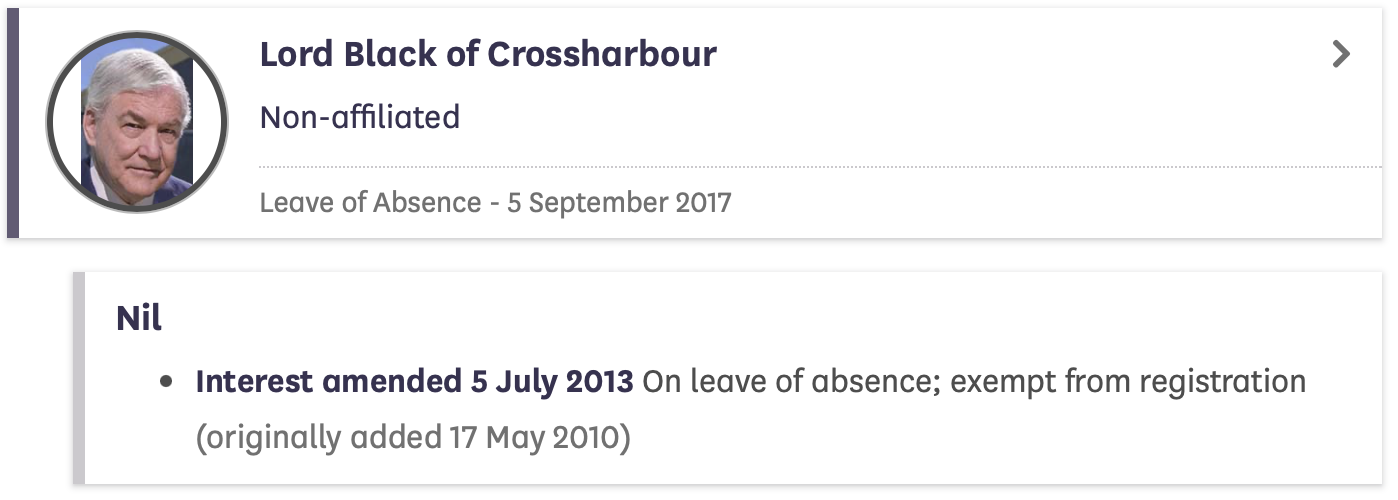
In her brutally frank 2020 memoir “Friends and Enemies” Amiel chronicles the sales of her husband’s London, New York and Palm Beach properties leaving him with his property at 26 Park Lane Circle which she describes as their “Toronto redoubt”. But that, too, has now gone. She recalls Black telling her:
“I’ve held out, but we have to sell this house… We have to get rid of the fourteen-million mortgage plus the million and a half annual running costs.”
She says she knew he was right.
She told the Tatler on 8 October 2021 there was a buy-back agreement on the Toronto mansion they had just left, but she suspects they’ll buy somewhere in the UK. She says they miss London and they miss their friends there.
“I want the world to open up. I want to be able to go to concerts. I, even at this horribly advanced age, want to go to a bar like Annabel’s and canoodle with Conrad in a corner.”
Clearly, Canada’s loss will be Britain’s gain.
This email address is being protected from spambots. You need JavaScript enabled to view it.
Explainer on non-domiciled status: The UK's Guardian newspaper revealed on Wednesday 6 April 2022 that the wife of the UK Chancellor of the Exchequer is non-domiciled. And what the tax experts say.

Conrad Black in the UK at the Cliveden Literary Festival October 2021. Still spinning a tale, he tells his audience:
“The late William F Buckley invited me to become a columnist for the National Review after I had been spuriously convicted as is now universally recognised and… at least it is acknowledged by the U.S. Government anyway…”
- Details
- Written by Gordon Prentice
This is a postscript to my last blog in which I expressed scepticism that the land donated by the developer, Marianneville, to the Town could be valued at over $14M. This is not funny money. It is bankable. The Tax Receipt issued by the Town will be used by the developer to offset tax otherwise owing to the Canada Revenue Agency. 
The Valuation Report jointly commissioned by the developer and the Town makes several “extraordinary assumptions”.
The valuer reserves the right to
“amend, alter, or otherwise change the final estimate of Market Value should any Extraordinary Assumption contained or identified herein prove to be invalid.”
Extraordinary Assumption
One very significant “extraordinary assumption” concerns the two stormwater ponds which lie in the donated lands. The valuer says:
“These are being considered, consistent with the industry norm, on the basis of being otherwise developable.”
Here comes the health warning – I am not a valuer or a pretend valuer but common-sense tells me it is a step too far to consider the stormwater ponds developable. Against this, we are told this is the way valuers do things and it is the industry norm.
Of course, stormwater ponds are not there in perpetuity. No doubt, advances in technology make a difference. But the two stormwater ponds on the donated land (ponds 12 and 13) continue to serve a purpose. (see note 1 below)
Stormwater ponds retained elswhere
In the rest of Glenway West the two existing stormwater ponds (10 and 11) have been retained and are being incorporated into the new development. No doubt because they fulfill a function.
The Town’s Comprehensive Stormwater Management Master Plan (June 2017) goes into huge detail about how and why these stormwater ponds are needed. I learn there are approximately 100 SWM ponds in Newmarket, 58 of which are owned and operated by the Town.
Ponds 12 and 13 on the donated land are permanent “wet ponds” and provide water quantity and quality control. There is nothing in the Master Plan that suggests they are no longer needed.
The table on the right (Table 3-7) tells us more about all the ponds in Newmarket. (The graphic shows an extract with statistics on ponds 10 to 13 at the bottom.)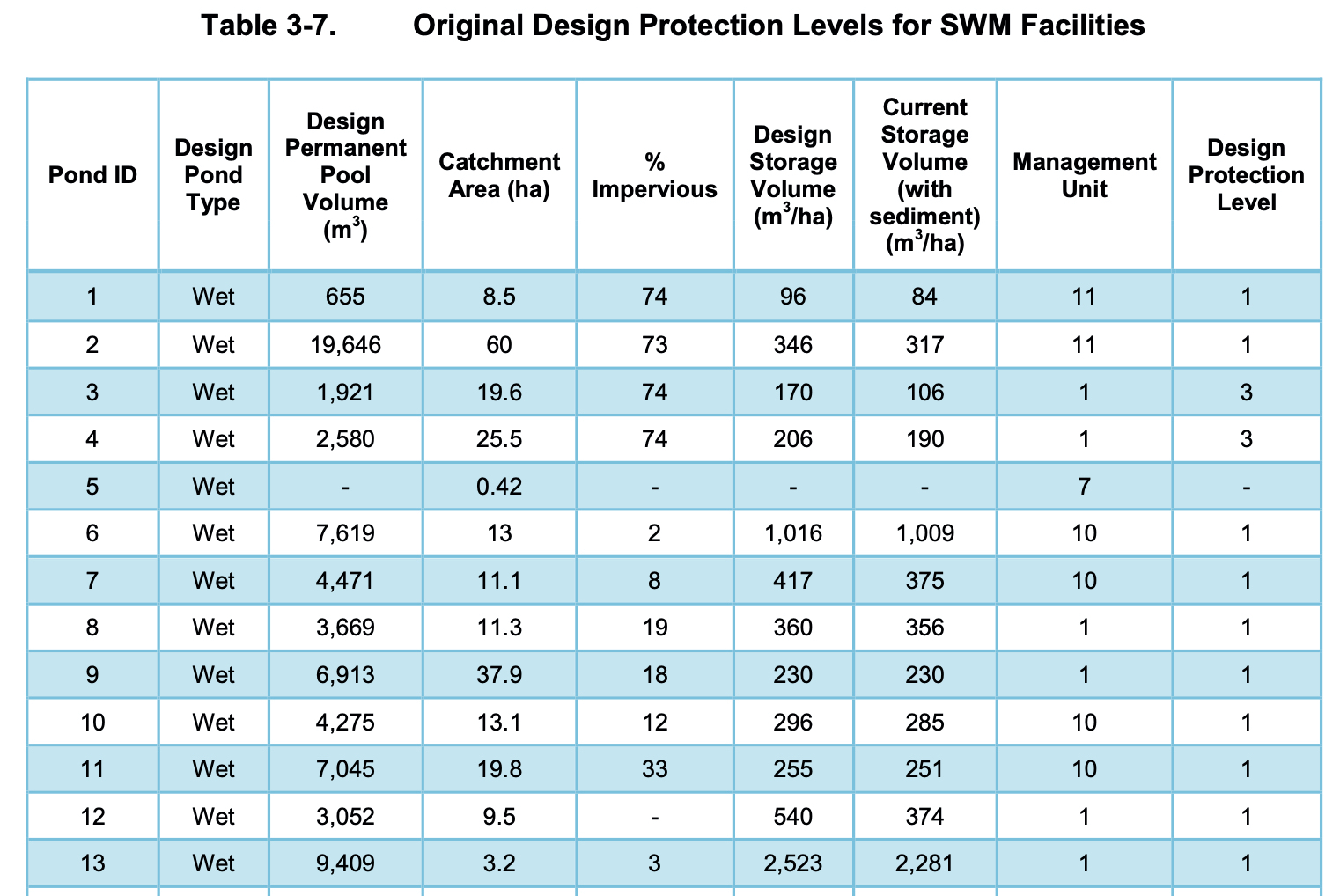
Ponds hold a lot of water
Pond 12 lies to the west of pond 13 and is the smaller of the two. Pond 12 has a design pool volume of 3,052 cubic metres and its sister to the east, pond 13, has a design volume of 9,409 cubic metres. An Olympic size swimming pool holds about 2,500 cubic metres of water.
The catchment area of pond 12 is over 23 acres and pond 13, almost 8 acres.
The valuer makes the extraordinary assumption that the two stormwater ponds are part of the 10.21 acres which are allegedly developable. If so, what happens to the water that they are designed to catch, hold and allow slowly to drain away through the soil?
Two ponds = 2.19 acres
The view of pond 12 shown below in my solid green is 0.82 acres.
Pond 13 is 1.37 acres.
If the ponds were to remain, plainly the amount of land available for development would be reduced - along with its estimated market value.
What would the Stormwater Master Plan say?
I find it difficult to believe the stormwater ponds are developable. But if they are, how would their removal be addressed in the Town’s Comprehensive Stormwater Management Master Plan?
Seems to me the valuer's "extraordinary assumption" is invalid.
And if so, the market value of the donated land needs revision.
This email address is being protected from spambots. You need JavaScript enabled to view it.
Update on 23 March 2022: From the Canada Revenue Agency:
The onus is on charities to ensure that the fair market value reflected on official donation receipts is accurate.
Stormwater Pond 12 with the pond area calculated as 0.82 acres below:


Stormwater Pond 13 and the pond area calculated as 1.37 acres below:


The Valuation Report says the land in green below is municipal open space and is undevelopable. So the development that is theoretically envisaged by the Valuation Report would be pushed to the East towards the stormwater ponds.

- Details
- Written by Gordon Prentice
On 14 December 2021 the Town gave a Donation (or Tax) Receipt for $14,290,000 in exchange for a 15.92 acre parcel of land at Glenway West which was gifted to the Town by Marianneville who didn't want it. The donation was agreed and publicized with great fanfare in June 2017. The title would transfer at a time of the Town’s choosing. 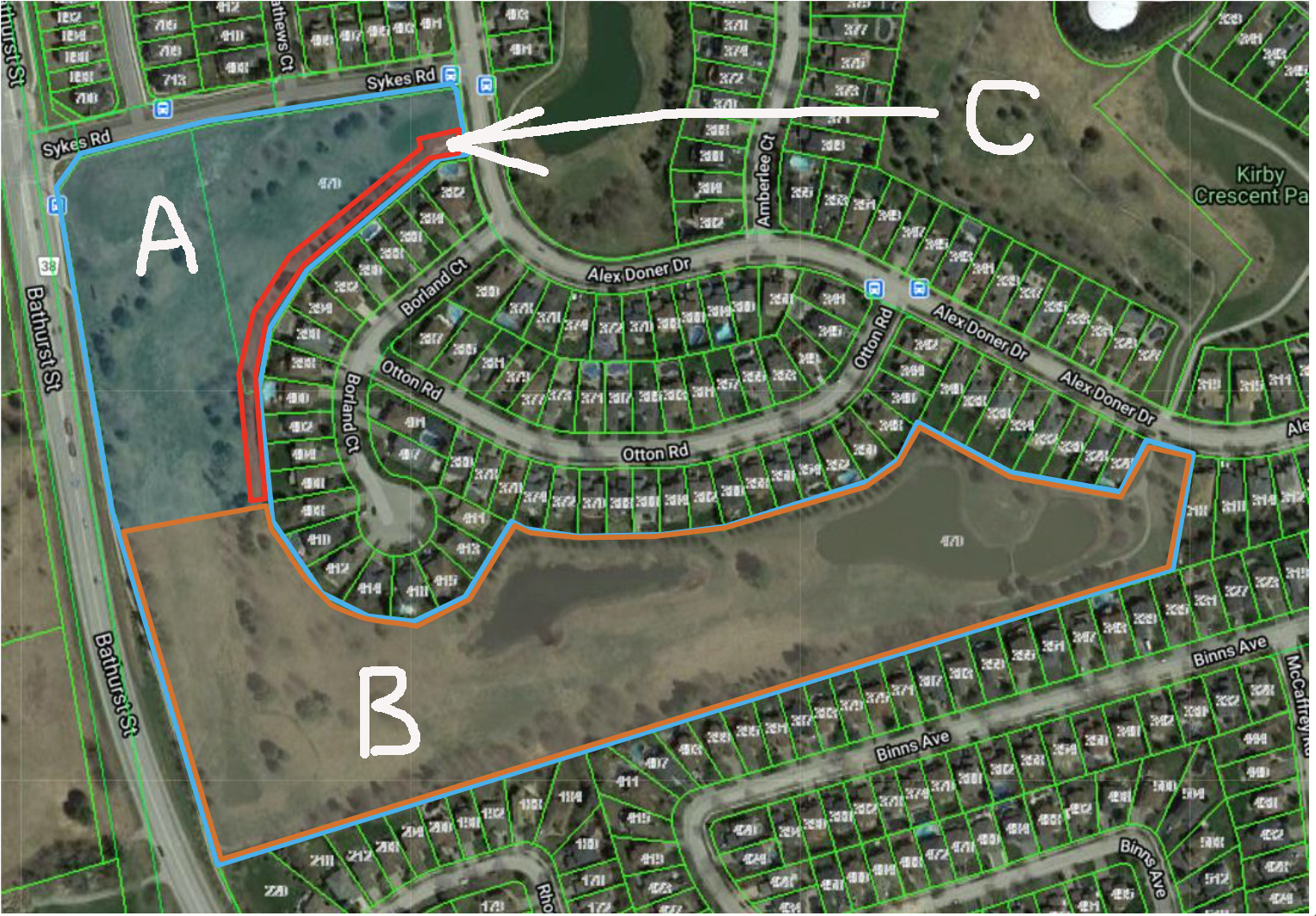
A tax receipt issued in exchange for a charitable donation can be used to offset taxes owing to the Canada Revenue Agency. It is as good as real money.
Background: The 140-acre golf course at Glenway was bought by the developer Marianneville on 21 January 2010 for $9,900,000 – around $71,000 per acre. The then owner - Glenway Country Club (1994) Limited - had offered it to the Town in 2008 but the Town wasn’t interested. Marianneville then went to the OMB in 2014 to get the golf course zoning changed from private open space to allow residential development. They succeeded.
The Mayor at the time, now Newmarket-Aurora’s Liberal MP, Tony Van Bynen, said the Town had stood shoulder to shoulder with local residents, valiantly fighting at the OMB to defend the Town’s Official Plan which showed Glenway as open space. This version of events is a complete fiction. The then Director of Planning, Rick Nethery, said the Town did not defend the Official Plan at the OMB. In fact, the Town’s planners boycotted the hearings and the Town’s case was put by an outside planner with limited knowledge of the Town’s planning policies and history.
Two Issues
Fast forward to December 2021… How did the land donation translate into a tax receipt for $14,290,000? There are two issues here (a) the rules which apply for offsetting tax otherwise owed to the Canada Revenue Agency and (b) whether the donated land could realistically be developed for medium density housing as suggested by the valuers, giving it a market value of over $14M.
The CRA rules on charitable donations of real property (ie land)
The CRA has strict rules which govern donations to charities (whose definition includes municipalities). The gift must be irrevocable and come with no strings attached. Crucially, the CRA needs to know the fair market value of the property at the time the gift was made.
The valuers estimated the fair market value of the donated lands on 26 February 2021:
“Any estimate of Market Value concluded in this Appraisal Report is based upon market conditions as (sic) the Effective Date of Valuation (ie 26 February 2021). This Appraisal Report does not provide a prediction of future or prospective Market Value.”
The donation receipt (and, presumably, the transfer of title) was made nine months later, on 14 December 2021.
The Valuers say their estimate of $14,290,000 is the most probable price the property could achieve “after reasonable exposure in a competitive market…” The Appraisal Institute of Canada says the concept of “reasonable exposure time” includes adequate, sufficient and reasonable marketing effort. It begs the question – how would the donated land, open space with two storm water ponds, be described and marketed? They would be marketed as land theoretically ripe for development. But they are not.
Donation Policy 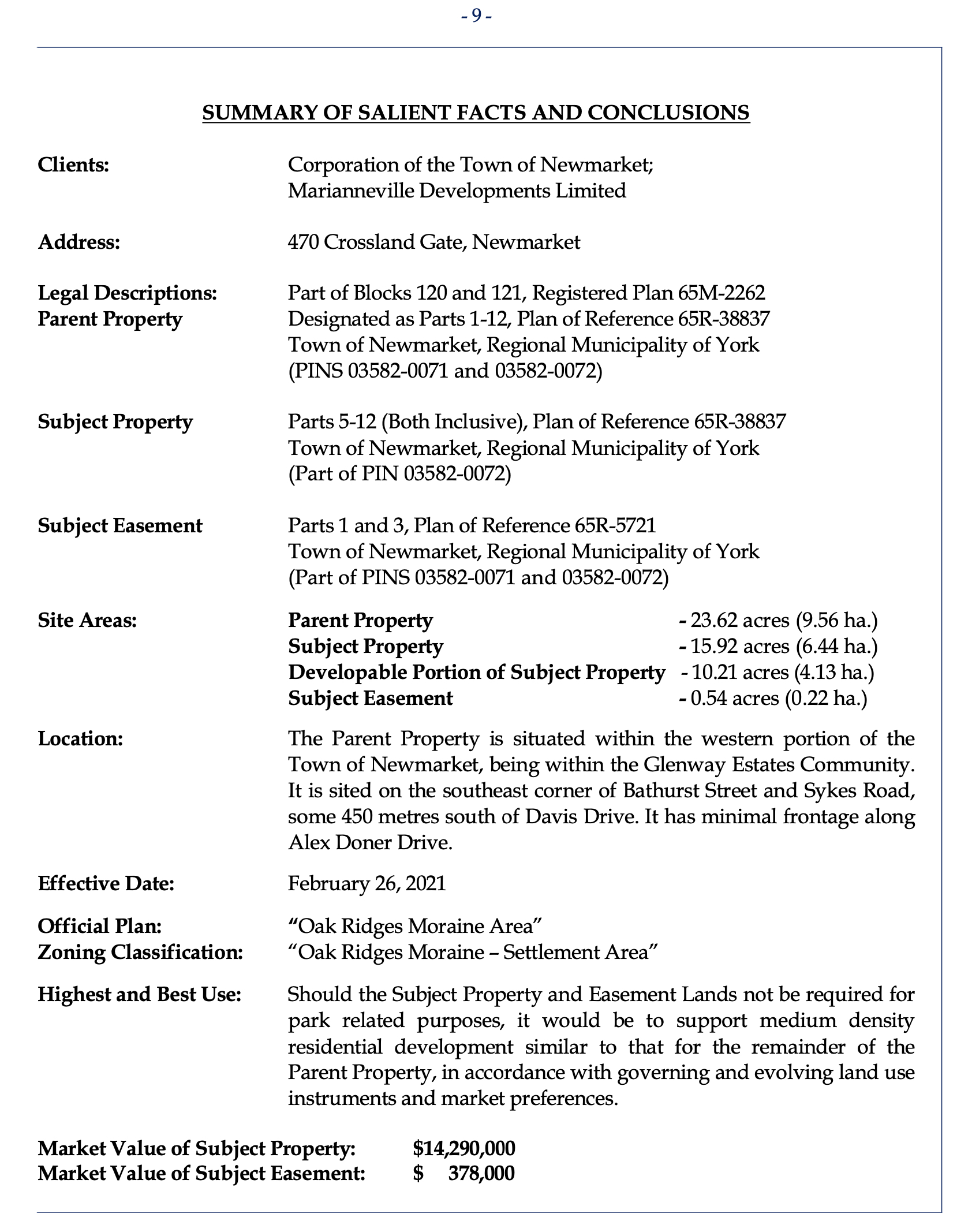
The Town accepts gifts in line with its donation policy. It says:
“Donations will not be accepted from persons who have a concurrent application of a permit or license from the Town or an application for planning approval from the Town, or from persons who are bidding for a contract from the Town through a procurement process.”
After the OMB’s decision in 2014, the Town and Marianneville were locked in an embrace, whether they liked it or not. Development was going to happen but the terms still had to be negotiated.
On 7 June 2017 the Town announced that an agreement had been reached with Marianneville who had decided to donate 16 acres of land around the former golf course’s 16th hole for public open space.
Gift of land separate from planning approvals
The Town emphasised that the donated land and any planning applications to develop the Glenway lands were to be regarded as completely separate. In their agreement on 9 May 2017 Marianneville acknowledged
“…that the terms of this agreement do not constitute in any way an approval of any future development proposal for any part of the lands known as the former “Glenway” lands, and that the owner shall still be required to proceed with the normal approval process for any future development of these lands.”
However, there was one thing that Marianneville wanted from the Town – a Tax Receipt.
“In consideration of the conveyance of the Lands and Stormwater Management Lands to the Town, (ie the donated lands) The Town agrees to provide a tax receipt to the Owner, as permitted under guidelines by the Canada Revenue Agency, reflecting the fair market value (FMV) of the (donated lands) and to place a recognition plaque within the (donated lands) acknowledging the donation of these lands to the Town.”
“The FMV will be determined by an appraisal of the Lands jointly commissioned by the Town and the Owner…”
The Valuers say their Report was commissioned:
“to assist in asset valuation related matters.”
Plainly, its primary purpose was to facilitate a Tax Receipt for the developer.
But is the land worth $14,290,000?
This is the second issue.
The donated land is in the Oak Ridges Moraine and is zoned as Open Space. It is marked “B” on the plan above and is referred to as the “subject property” by the valuers.
It lies directly to the south of a block earmarked for Townhouse development (marked as “A” on plan). Together “A” + “B” + “C” (an easement "C" allows for a proposed trail to loop through the new development) constitute the so-called “parent property”.
Marianneville’s Joanne Barnett told Newmarket Today on 30 December 2021 that the donated lands around the former 16th hole of the golf course worked for a trail system but were less suitable for housing:
“They supported two stormwater ponds and segued nicely into the woodlot there. It was a nice fit.”
But the valuers, commissioned jointly by the developer and the Town - with a brief to estimate the fair market value of the donated land should it “not be required for park related purposes” - say the land is suitable for medium density residential development.
Market Value for the Highest and Best Use of the land
To get the estimated market value, the valuers chose to compare the townhouse block “A” with its planned 96 townhouses to the donated block “B”. They say their appraisal report has been:
“completed in accordance with the Canadian Uniform Standards of Professional Appraisal Practice as adopted by the Appraisal Institute of Canada.”
The Institute says that when giving an opinion on the “Highest and Best Use” of a property the appraiser should give an opinion
"on the land, as if vacant, and the property, as improved"
Here, the valuers only give an estimate of the donated land as developed – not as undeveloped open space.
The Institute says that providing an estimate of market value for the land alone depends on the "scope of the assignment".
Stormwater Ponds
The donated land sits, in part, on a Significant Water Recharge Area and contains two large Storm Water Ponds. It is surrounded on three sides by a long-established residential neighbourhood characterised by single detached houses. The valuers say that of the 15.92 acres 10.21 are developable.
“Part 5, Plan of Reference 65R-38837 has an area of 5.71 acres and represents lands intended for green space or other municipal purpose. For the purposes of this Report, these lands are assumed to be non-developable.”
The undevelopable portion of the donated lands lies in the western third, alongside Bathurst Street. (See plan below)
The argument for a townhouse development on Block “A” turned, in large measure, on its adjacency to Bathurst.
Extraordinary Assumptions
The valuers make several “extraordinary assumptions” in arriving at the fair market value of the donated land. The two stormwater ponds
“are being considered, consistent with the industry norm, on the basis of being otherwise developable.”
But this is absurd. Other plans submitted by the developer show drainage patterns on adjacent lands, feeding water into the two ponds which are now deemed by the valuers to be developable.
The valuers say they reserve the right to amend their final estimate of market value should any of their extraordinary assumptions “prove to be invalid”.
Developing stormwater ponds is one assumption that is certainly invalid.
Flawed
The Valuation Report is flawed in other respects. Plans are incorrectly labelled. For example, in the graphic on page 29 they confuse the Parent Property with the so-called Subject Property. The key agreement between the Town and Marianneville dated 9 May 2017 is mistakenly dated 18 January 2017 – the date of the earlier agreement.
The valuers did not formally search the Title on the Land Registry. Instead, they relied on secondary sources. They say:
“A review of these sources has indicated that the Parent Property was purchased by Marianneville Developments Limited from Glenway Country Club (1994) Limited on January 21, 2010 for a total consideration of $9,900,000”
This is incorrect.
The Parent Property (“A” + “B” + “C”) totals 23.62 acres or about one sixth of the 140-acre Glenway Golf Club purchased by Marianneville in 2010.
Significant Water Recharge Area
The donated land and the block to the north proposed for townhouse development both straddle a Significant Water Recharge Area where rain and melting snow can easily penetrate the soil and replenish the aquifer which lies under the Town. (Shown in solid striped pink)
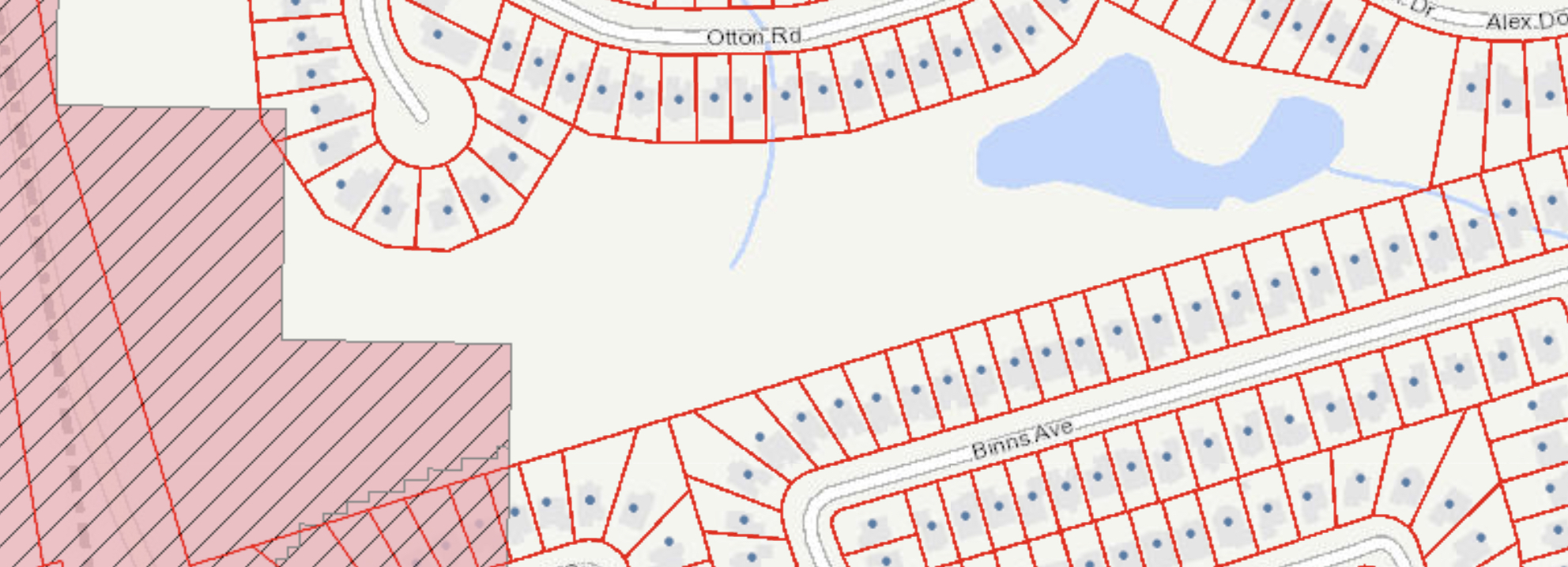
The valuers say they have no knowledge of soil conditions but they are “assumed to be adequate for intended uses”.
The Lake Simcoe Region Conservation Authority confirms it is possible to build on a Significant Water Recharge Area but it must be a “low impact development” where the amount of water penetrating the soil must be the same pre and post development – the so-called water balance. This is not a straightforward matter. Across the proposed development the amount of water seeping into the soil post-development compared with pre-development is estimated to decrease by the annual equivalent of two Olympic sized swimming pools. That is an issue that has to be - and will be - addressed. It was flagged up as an issue early on by Cole Engineering who warned of the:
"potential long-term impacts to the groundwater system associated with the development include: reduction in infiltration, introduction of preferential pathways for contaminants such as road salt, and reduction of quantity of groundwater available to nearby shallow well systems. Existing shallow water table and proposed site grading could also influence groundwater seepage into the basements in the proposed development." (Click "Read More" below)
These ‘low impact developments” are still innovative. The Director of Planning, Jason Unger, told a Council workshop on “development and the environment” on 21 March 2021 that:
“It wasn’t all that long ago that they (low impact developments) were kinda rare… but now we are looking to see (LID) right up front. So (we ask developers) what are you doing from an LID perspective and Stormwater Management perspective?”
Would townhouses fit in if the donated land were developed?
Any new development would have to be compatible with the surrounding established neighbourhood. The issue of compatibility has always been key to the development of the former golf course.
At the Statutory Public meeting on 3 February 2020 many residents – including the Ward Councillor, Christina Bisanz, expressed concerns about the density of the Townhouse block (Block A). The developer has since proposed some design changes to the Townhouses and points to the separation between the Townhouses and Borland Crescent (where the trail is planned to run) but has said nothing about the overall density. The developer's presentation slides are here. And the video of the meeting at 7pm is here.
The Compatibility Interface Plan, drawn up by the developer’s planning consultants, Zelinka, says:
“The new 3-storey townhouse dwellings will not abut any existing single detached dwelling lots.”
But a development on the donated Block "B" cannot avoid abutting the existing single detached houses – especially since the development would have to be pushed away from the Bathurst Street frontage. This would inevitably bring compatibility issues with it. This is not addressed in the Valuation Report but is central to any assessment of what could likely be built on the donated land.
For all these reasons I believe the valuation is unsafe.
The Canada Revenue Agency should ask for a new valuation of the donated land before the tax receipt for $14,290,000 can be used by Marianneville to offset tax otherwise owing.
This email address is being protected from spambots. You need JavaScript enabled to view it.
Note: The two agreements between the Town and Marianneville dated 18 January 2017 and 9 May 2017 and the Valuation Report were made available to me following Freedom of Information requests.
See also my earlier blog from 25 January 2022. Is the land worth $14M?
Update on 20 March 2022: Text corrected to show estimated water infiltration is calculated across the development and not just from the Townhouse Block. The Beacon Environmental Impact Study (June 2021) (For details: Click "Read More")

Page 74 of 284